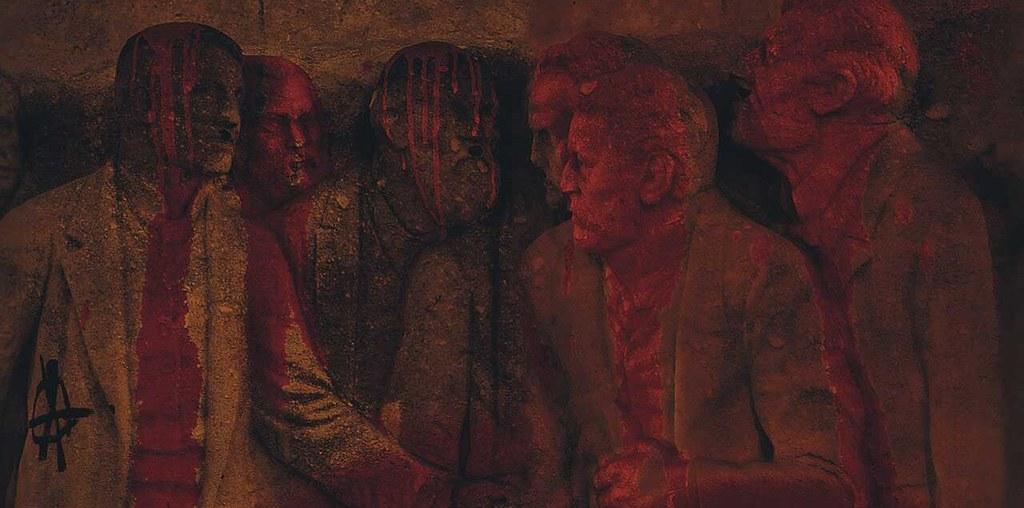TONSPUR 95 & TONSPUR_display #14

Verbindung zu esel.at

Playing Lueger & Playing Lueger/Happening
TONSPUR für einen öffentlichen raum 2025
TONSPUR_passage | Micro Museum for Sound
13 Oct—29 Nov 2025
TONSPUR_display | Showroom TONSPUR Kunstverein Wien
13 Oct 2025—4 Feb 2026
ARYE WACHSMUTH & SIMON WACHSMUTH • PLAYING LUEGER
What does an object sound like when it is activated acoustically? What comes back as an echo? Do the sounds and the resonance begin a dialogue between a sculpture and its setting? “Playing Lueger” engages with these questions.
Monuments are part of our everyday lives as places of commemoration, of remembrance and of protest. They store history and pass it on to generations to come. However we bear the responsibility for the way we perceive, interpret and evaluate them today. The philosopher Henri Lefebvre saw monuments as dialectical objects — both collective repositories and carriers of ideological significance. In our work, the monument in Vienna’s 1st district, The Inner City, to the anti-Semitic mayor of Vienna Karl Lueger becomes a point of departure for talking about memory and responsibility — and about how cultural heritage can be ‘heard’ in new ways.
We transform the monument into an instrument. Using specially developed mallets, we beat on the bronze sculpture — like a percussion instrument. This gesture has a double meaning: it is associated with violence, while at the same time being prerequisite for making the sounds, the vibrations, and hearing. Bells and gongs are instruments that serve both as signals and for meditation. “Playing Lueger” reflects the tension between destruction and renewal, between physical action and symbolic sounds. The noise becomes a metaphor for social resonance — for speech and counter-speech, for asking questions and responding.
The acoustic activation provides the basis for a sound installation in public space that also engages with Vienna’s rich musical history as part of its conceptual framework. While Mahler and Schönberg were searching for new forms of expression, Lueger’s populist and anti-Semitic politics was shaping the cultural climate of the city. A central figure of this era was Elsa Bienenfeld, a musicologist, critic and pioneer of New Music. She stood for openness and renewal at a time when anti-Semitism was hostile towards the avant-garde — and she was murdered in the Maly Trostinec extermination camp. Her last place of residence, a collective apartment for Jews, was only a few meters away from Dr. Karl Lueger Platz. A quotation from Bienenfeld has been integrated into the sound piece. It addresses the relationship between tradition and renewal as a poetic call for differentiation instead of exclusion.
“Playing Lueger” transforms the monument — a symbol of a troubled past — into an open sonic structure. The monument becomes a resonating body that makes history audible, and asks: How do we deal with the echoes of our own past today?
A. WACHSMUTH & S. WACHSMUTH • PLAYING LUEGER/AKTION
There is ambivalence in the gesture of striking something — and a moment of humour. On the one hand, beating something represents violence as a physical act that could cause damage/injury, while not being exclusively destructive. If you don’t hit a nail, you can’t drive it into wood, you beat cream, you need to thump a drum.
Violence can be physical, psychological or verbal. Language can also cause pain — as demonstrated by the polemics of politician Karl Lueger, a prime example of exclusionary and inflammatory speech. Beating Lueger’s statue to produce the acoustic source material for the sound installation of the same title for TONSPUR_passage can be interpreted as a gesture of resistance or of criticism. It refererences the politician’s body as a symbol of power, which is acoustically activated and reinterpreted when it is struck, while also highlighting the space that this person is given in public. The resulting sound is both a remnant and documentation of an audible provocation of the representation. Instead of merely observing the statue, its physical presence becomes audible. The sound reveals something about the substance of power: solid, hollow, fragile or resistant. It shows that the representative is not immutable — it can be altered through touch, gestures and actions. Striking the statue makes the past reverberate and creates resonance in the present. The echo can be understood as a response — as a reflection of the material beyond approval or rejection. Sound becomes a form of appropriation here. The monument loses its silence and becomes an instrument. A rigid representation is transformed into a lively process. The production of the sounds connects with the resonance of the space and opens a dialogue between the statue, the city and society. The sound transcends the boundaries of the material and integrates the work into its acoustic environment, where the public space itself becomes a sounding board for social significance. Whether the sounds clash with or complement one another — and whether the artwork is strikingly apt — remains open. Like the sound in the space, this question is also lost in resonance: a movement without a destination, where the direction is neither controlled nor predictable.